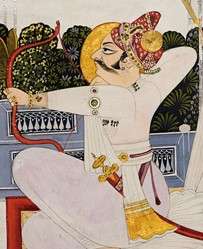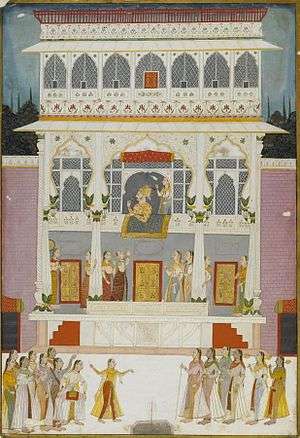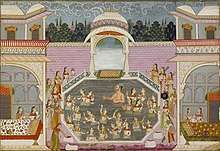Bakht Singh of Marwar
Maharaja Bakht Singh or Bakhat Singh (16 August 1706 – 21 September 1752) was an 18th-century Indian Raja of the Rathore Clan. Born in 1706, he ruled over various domains in the Jodhpur and Marwar states and was a major political force during his life.[1][2]
| Maharaja Bakht Singh | |
|---|---|
| Maharaja of Jodhpur and Marwar | |
 Jodhpur style painting depicting Bhakt Singh practicing archery, circa 1750 | |
| Reign | July 1751 – 21 September 1752 |
| Coronation | 8 July 1751 |
| Born | 16 August 1706 Meherangarh, Jodhpur |
| Died | 21 September 1752 (aged 46) Sindholi |
| House | Rathore |
| Father | Ajit Singh |
| Religion | Hinduism |
Early life and political ascension

Bakht Singh was born on 16 August 1706 as the second son of Ajit Singh. At the time of Bakht's birth his family was in active revolt against the Mughal Empire due to an ongoing territorial dispute over Gujarat.[3] His father was pardoned by Muhammad Azam Shah in 1708, granting the Rathore clan control over the Kingdom of Marwar and the city of Jodhpur.[4][5]
In 1724 Bakht Singh and his elder brother Abhai Singh plotted to kill their father and usurp his position as Raja. They succeeded, and Abhai Singh became the Maharaja of the Kingdom of Marwar and Jodhpur.[6] This abrupt change of leadership sparked a brief civil war among the Rathore in Marwar, during which the brothers employed Maratha soldiers to fight their enemies.[1] At this time Marwar was a vassal of the Mughal Empire, which was in constant conflict with the Maratha Empire. The allowing of Maratha soldiers onto Mughal territory to solve a domestic dispute effectively estranged the Rathore from the Mughal government.[1]
Siege of Ahmedabad
In 1730 a taxation depute against Sarbuland Khan (Nawab of Gujarat) resulted in Abhai Singh laying siege to the city of Ahmedabad.[7] Bakht Singh personally led the storming of the city, the Marwar army lost 120 soldiers and 700 were injured while Sarbuland Khan lost his son in the cannonade and most of his men were slaughtered along with high ranking Mughal Mansabdars (nobles), some ranking as high as 3,000. Sarbuland Khan surrendered after three days of fighting, after which the Mughal emperor was forced to make Abhai Singh the lord of Ahmedabad and the governor of Gujarat.[8] Bakht Singh was commended for his bravery during the battle.[1][7]
Lordship and Battle of Gangwana

By 1739 Bakht Singh had been appointed lord of Nagaur. Seeking to expand his influence, he attempted to force concessions from the Bikaner State, calling on his brother for support. The Raja of Bikaner sent a letter to Jai Singh II, the powerful Maharaja of the Kingdom of Jaipur, requesting assistance. Jai Singh sent a letter to Abhai Singh asking for leniency to be shown to Bikaner, a request Abhai sharply refuted.[1] Seeking to end the conflict, Jai Singh dispatched his minister Vidyadhar to Bhakt Singh. Bakht agreed to withdraw his men from the conflict if he were paid by Jaipur and given the town of Merta. This was done, and with Bakht Singh now removed as a threat, Jai Singh was able to force a peace with Marwar. Unable to face Jaipur alone, Abhai Singh was forced to sign a treaty with Jai Singh. The Kingdom of Marwar was forced to pay 1 lakh (100000) rupees to the Mughals, 20 lakh (2000000) to Jaipur, give up hostages, and was prohibited from sending emissaries to the Mughal court without the express approval of Jai Singh.[1] The latter condition effectively made Marwar a vassal of Jaipur, as Abhai could no longer request aid from the Mughal government. The treaty enraged many members of the Rathore clan, most of whom felt that Bakht Singh was responsible for the disaster.[1]
In 1741 Abhai Singh began to gather his forces in Jodhpur in preparation for a war of revenge against Jaipur. Jai Singh detected these movements and gathered his army (of 40000-100000 men) to invade Marwar.[9] As the Jaipur army advanced, Bakht Singh arrived at Merta, the forward camp for the Rathore and Marwar army. He entered the Raja's durbar, where he was chastised by his fellow Rathors for his betrayal.[1] Bhakt accepted his wrongdoing, and promised to lead his personal cavalry contingent (of 1000 men) against the oncoming Jaipur.[1]
In the ensuing Battle of Gangwana Bakht Singh and his cavalry succeeded in inflicting heavy casualties on the Jaipur army.[9] Over 12000 Rajputs and Mughals were killed, losses so high that Jai Singh ended the campaign and was forced to accept a mediated peace with Abhai Singh. Bakht Singh, wounded by both a bullet and an arrow during the fighting, was once again praised for his valor.[1][9]
Later life
On 17 June 1749 Abhai Singh died, with his eldest son Ram Singh succeeding him. Bhakt Singh (his uncle) disagreed with this primogeniture and rose up in revolt. Bakht Singh emerged triumphant in the battle of Luniawas, becoming the Maharaja of Marwar and Jodhpur in July 1751. Bhakt Singh's first step as a ruler was to raise an army in Ajmer and to start fortifying his holdings to protect Marwar from external threats like the Mughals, Marathas and Afghans. However, not much was achieved, due to his sudden death on 21 September 1752. According to Persian historians, he died by cholera while Vir Vinod claims that he was poisoned by Madho Singh I.[10][11][12] His son Vijay Singh inherited his titles. The Rathore civil war between Vijay Singh and Ram Singh that would follow after Bakht Singh's death ultimately led to the downfall of the Rathore clan.[13][14][12]
See also
- Rulers of Marwar
Bibliography
- R.K Gupta, S.R Bakshi (2008). Rajasthan Through the Ages, Vol 4, Jaipur Rulers and Administration. Sarup & Sons. ISBN 9788176258418.
- Jodhpur and the Later Mughals, AD 1707–1752, by R. S. Sangwan. Published by Pragati Publications, 2006.
- Sir Jadunath Sarkar (1994). A History of Jaipur 1503–1938. Orient Longman. ISBN 81-250-0333-9.
- Faruqui, Munis D. (2012). The Princes of the Mughal Empire, 1504–1719. Cambridge University Press. p. 316. ISBN 978-1-107-02217-1.
- Gazetteer of the Bombay Presidency: Ahmedabad. Google Books 2015 (Public Domain text). 7 January 2015. pp. 248–262. Retrieved 1 February 2015.
- Richards, John F. (1995). The Mughal Empire (Reprinted ed.). Cambridge University Press. pp. 180–181. ISBN 978-0-52156-603-2.
References
- Gupta, Bakshi pp. 152–155
- "Maharaja Bakht Singh". geni_family_tree. Retrieved 2 May 2017.
- N.S. Bhati, Studies in Marwar History, page 6
- Munis pp. 316
- Richards pp. 180–181
- "Maharaja Shri Ajit Singh Rathore jodhpur". geni_family_tree. Retrieved 2 May 2017.
- Google Books 2015, pp. 256–257.
- Visheshwar Sarup Bhargava,"Marwar and the Mughal emperors (A. D. 1526–1748)", page 153
- Sarkar pp. 200
- Rajasthan Through the Ages By R.K. Gupta, S.R. Bakshi pg.156
- Fall Of The Mughal Empire- Vol. I (4Th Edn.), Volume 1 By Jadunath Sarkar pg.199–200
- "JODHPUR9". www.royalark.net. Retrieved 2 May 2017.
- Jodhpur and the Later Mughals, AD 1707–1752, by R. S. Sangwan. Published by Pragati Publications, 2006.
- "Maharaja Bijay Singh". geni_family_tree. Retrieved 2 May 2017.
External links
| Wikimedia Commons has media related to Bakhat Singh of Marwar. |